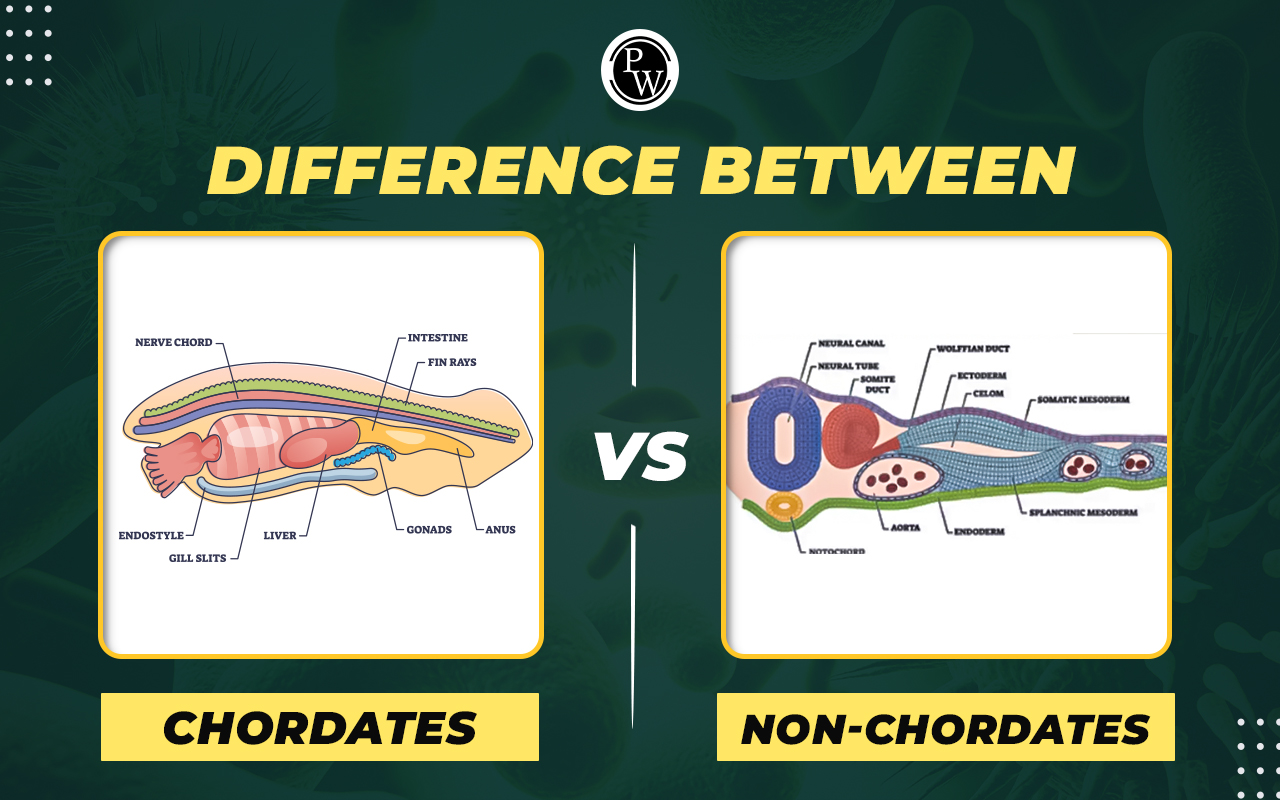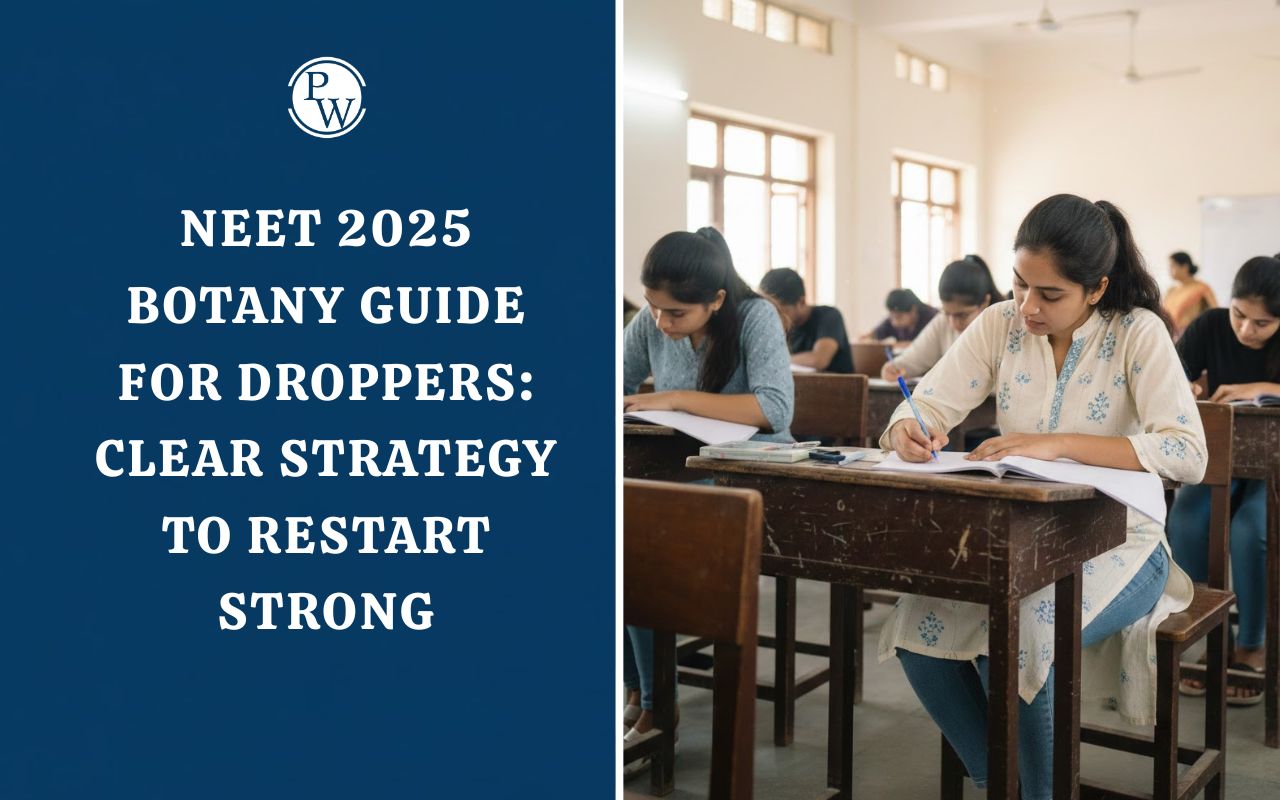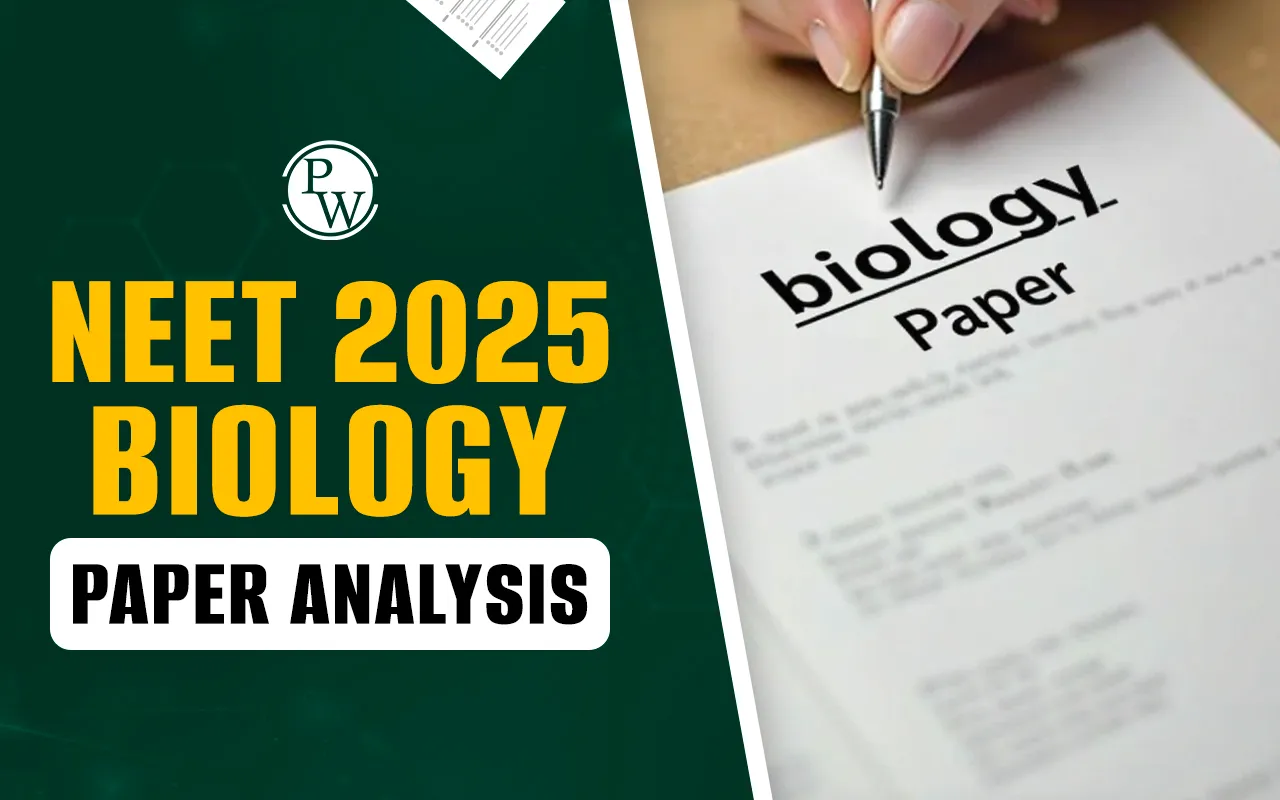

Difference Between Chordates and Non-Chordates: Chordates and Non-chordates are mainly distinguished by whether they have a key structure known as the notochord at some stage in their life. Nevertheless, there exist several additional distinctions that set apart these two categories of living beings. Continue reading to understand the variations between chordates and non-chordates.
| NEET Biology Syllabus | NEET Biology Diagrams |
| NEET Biology MCQ | NEET Biology Chapter wise Weightage |
| NEET Biology Notes | NEET Previous Year Question papers |
Difference Between Chordates and Non-Chordates Overview
Chordates and non-chordates represent distinct phyla within the animal kingdom, characterised by fundamental anatomical and developmental differences. Chordates possess a notochord—a flexible rod-like structure—during some stage of their life cycle, along with a dorsal hollow nerve cord, pharyngeal slits, and a post-anal tail. These features may be present only in embryonic stages in some species. Conversely, non-chordates lack such specialised structures and include diverse groups like arthropods, mollusks, and annelids. While chordates exhibit greater complexity and are generally vertebrates, non-chordates comprise mainly invertebrates. This distinction underpins evolutionary divergence, leading to varied physiological and ecological adaptations in both groups.Difference Between Chordates and Non-Chordates
Chordates and non-Chordates differ a lot from each other in many aspects. Here's a detailed difference table of chordates and non-chordates:| Difference Between Chordates and Non-Chordates | ||
|---|---|---|
| Feature/Characteristic | Chordates | Non-chordates |
| Presence of Notochord | Have a notochord (a flexible rod-like structure) at some stage of their life. | Lack a notochord throughout their life cycle. |
| Dorsal Hollow Nerve Cord | Possess a dorsal hollow nerve cord (or neural tube) that runs along their back. | May have a nervous system, but not organised into a dorsal hollow nerve cord. |
| Pharyngeal Slits | Exhibit pharyngeal slits or pouches at some point in their development. | Generally do not have pharyngeal slits. |
| Post-anal Tail | Most have a post-anal tail at some stage of development or throughout life. | Typically lack a post-anal tail. |
| Endostyle/Thyroid Gland | Have an endostyle (which can develop into the thyroid gland in some species). | Generally lack an endostyle or thyroid gland. |
| Circulatory System | Possess a closed circulatory system with a heart and blood vessels. | May have an open or closed circulatory system; if present, it's less organised than in chordates. |
| Respiratory Organs | Gills, lungs, or both are present for respiration, depending on the species. | Respiration occurs through various methods like diffusion through the body surface or specialised structures like gills. |
| Body Symmetry | May exhibit bilateral symmetry. | Can exhibit radial, bilateral, or no symmetry. |
| Exoskeleton | Generally lack an exoskeleton. | Some may have an exoskeleton made of chitin or calcium carbonate. |
| Reproductive System | Sexual reproduction is common; some species are hermaphrodites. | Reproduction varies widely, including sexual and asexual methods. |
| Examples | Humans, fish, birds, reptiles, amphibians. | Insects, worms, mollusks, echinoderms, cnidarians. |
What Are Chordates?
Chordates are a diverse group of animals that belong to the phylum Chordata. This phylum is characterised by several unique features that distinguish chordates from other animal groups. Here's a detailed overview of chordates:- Notochord: This is a flexible, rod-like structure that runs along the length of the body, providing support. In most vertebrates, such as fish, the notochord is replaced by the vertebral column (backbone) during development. However, in some animals like adult lampreys, the notochord persists throughout life.
- Dorsal, hollow nerve cord: Chordates have a nerve cord that runs along their dorsal (back) side. This nerve cord is hollow and develops into the central nervous system, which includes the brain and spinal cord.
- Pharyngeal slits or pouches: These are openings in the pharynx (the region just behind the mouth) that connect to the outside environment. In some chordates, such as fish, these slits function in filter-feeding, while in others, they play roles in respiration or develop into structures like the Eustachian tubes and tonsils in mammals.
- Post-anal tail: Chordates have a tail that extends beyond the anus at some point during their development. This tail may be present only in the embryonic stage and may be reabsorbed later, or it may persist throughout the organism's life.
What Are Non-Chordates?
Non-chordates refer to a diverse group of animals that do not possess a notochord during any stage of their development. The notochord is a flexible rod-like structure found in chordates, which includes vertebrates (animals with backbones) as well as some invertebrates.- Absence of Notochord: As the defining characteristic, non-chordates lack a notochord. This means they do not have a supportive, rod-like structure running along their back.
- Diverse Body Plans: Non-chordates exhibit a vast range of body plans, from simple to complex. This includes animals such as sponges, cnidarians, mollusks, arthropods, echinoderms, and many others.
- Varied Lifestyles: Due to the diverse nature of non-chordates, they can be found in various habitats, including marine, freshwater, and terrestrial environments.
Difference Between Chordates and Non-Chordates FAQs
What are examples of chordates and non-chordates?
Chordates include animals like humans and fish with a notochord, while non-chordates, such as insects and mollusks, lack a notochord.
What is the main difference between chordates and vertebrates?
All vertebrates are chordates, but not all chordates are vertebrates. Vertebrates have a vertebral column (backbone), while some chordates, like tunicates, lack this feature.
What is the difference between a chordate and a Chordata?
"Chordate" is a general term for animals with a notochord, while "Chordata" refers to the specific phylum encompassing all animals with a notochord.
What are the 9 types of non-chordates?
The 9 types of non-chordates include Porifera (sponges), Coelenterata (cnidarians), Platyhelminthes (flatworms), Nematoda (roundworms), Annelida (segmented worms), Arthropoda (arthropods), Mollusca (mollusks), Echinodermata (echinoderms), and Hemichordata (hemichordates).
What is the difference between chordates, non-chordates, and Hemichordates?
Chordates have a notochord, non-chordates lack it, and hemichordates possess a structure resembling a notochord called a stomochord. These are distinct phyla in the animal kingdom.
🔥 Trending Blogs
Talk to a counsellorHave doubts? Our support team will be happy to assist you!

Check out these Related Articles
Free Learning Resources
PW Books
Notes (Class 10-12)
PW Study Materials
Notes (Class 6-9)
Ncert Solutions
Govt Exams
Class 6th to 12th Online Courses
Govt Job Exams Courses
UPSC Coaching
Defence Exam Coaching
Gate Exam Coaching
Other Exams
Know about Physics Wallah
Physics Wallah is an Indian edtech platform that provides accessible & comprehensive learning experiences to students from Class 6th to postgraduate level. We also provide extensive NCERT solutions, sample paper, NEET, JEE Mains, BITSAT previous year papers & more such resources to students. Physics Wallah also caters to over 3.5 million registered students and over 78 lakh+ Youtube subscribers with 4.8 rating on its app.
We Stand Out because
We provide students with intensive courses with India’s qualified & experienced faculties & mentors. PW strives to make the learning experience comprehensive and accessible for students of all sections of society. We believe in empowering every single student who couldn't dream of a good career in engineering and medical field earlier.
Our Key Focus Areas
Physics Wallah's main focus is to make the learning experience as economical as possible for all students. With our affordable courses like Lakshya, Udaan and Arjuna and many others, we have been able to provide a platform for lakhs of aspirants. From providing Chemistry, Maths, Physics formula to giving e-books of eminent authors like RD Sharma, RS Aggarwal and Lakhmir Singh, PW focuses on every single student's need for preparation.
What Makes Us Different
Physics Wallah strives to develop a comprehensive pedagogical structure for students, where they get a state-of-the-art learning experience with study material and resources. Apart from catering students preparing for JEE Mains and NEET, PW also provides study material for each state board like Uttar Pradesh, Bihar, and others
Copyright © 2025 Physicswallah Limited All rights reserved.
Get App











